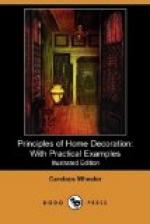What I have said with regard to painted walls in plain tints applies to bedrooms of every grade, but where something more than merely agreeable colour effect is desired a stencilled decoration from the simplest to the most elaborate can be added. There are many ways of using this method, some of which partake very largely of artistic effect; indeed a thoroughly good stencil pattern may reproduce the best instances of design, and in the hands of a skilful workman who knows how to graduate and vary contrasting or harmonising tints it becomes a very artistic method and deserves a place of high honour in the art of decoration.
[Illustration: 1, AND 2, STENCILED BORDERS FOR BATH-ROOM DECORATION: 3, 4, AND 5, STENCILED BORDERS FOR HALLS (BY DUNHAM WHEELER)]
Its simplest form is that of a stencilled border in flat tints used either in place of a cornice or as the border of a wall-paper is used. This, of course, is a purely mechanical performance, and one with which every house-painter is familiar. After this we come to borders of repeating design used as friezes. This can be done with the most delicate and delightful effect, although the finished wall will still be capable of withstanding the most energetic annual scrubbing. Frieze borders of this kind starting with strongly contrasting colour at the top and carried downward through gradually fading tints until they are lost in the general colour of the wall have an openwork grille effect which is very light and graceful. There are infinite possibilities in the use of stencil design without counting the introduction of gold and silver, and bronzes of various iridescent hues which are more suitable for rooms of general use than for bedrooms. Indeed in sleeping-rooms the use of metallic colour is objectionable because it will not stand washing and cleaning without defacement. The ideal bedroom is one that if the furniture were removed a stream of water from a hose might be played upon its walls and ceiling without injury. I always remember with pleasure a pink and silver room belonging to a young girl, where the salmon-pink walls were deepened in colour at the top into almost a tint of vermilion which had in it a trace of green. It was, in fact, an addition of spring green dropped into the vermilion and carelessly stirred, so that it should be mixed but not incorporated. Over this shaded and mixed colour for the space of three feet was stencilled a fountain-like pattern in cream-white, the arches of the pattern rilled in with almost a lace-work of design. The whole upper part had an effect like carved alabaster and was indescribably light and graceful.
The bed and curtain-rods of silver-lacquer, and the abundant silver of the dressing-table gave a frosty contrast which was necessary in a room of so warm a general tone. This is an example of very delicate and truly artistic treatment of stencil-work, and one can easily see how it can be used either in simple or elaborate fashion with great effect.




